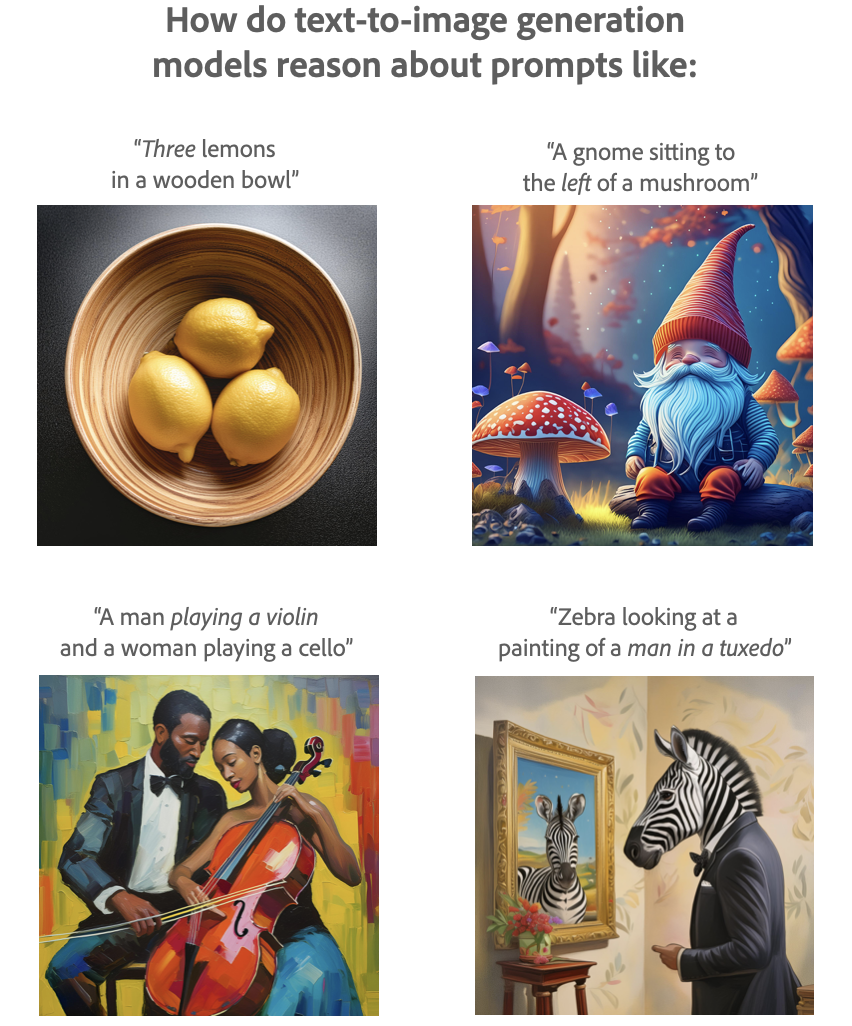
At Adobe, I'm an Applied Scientist working to improve GenAI image & video systems. I received my PhD in Experimental Psychology from UC San Diego, under Dr. Judith Fan @ The Cognitive Tools Lab.
Broadly, I study how people create, interpret, and interact with visual content through large-scale human behavioral crowdsourcing. By conducting a wide range of custom coded web experiments, I collect datasets of up to >90K human responses in order to systematically measuring people's visual content creation. This scale of data enables me to statistically evaluate GenAI algoritms, heuristic models, and LLMs against human behavioral and communication benchmarks.
My disseration research specialized in understanding user intentions in visual content creation—specifically, how content creators' different goals to make diverse visual content directly impacts:
I evaluated these questions by developing and analyzing large-scale drawing, diagram, and data visualization datasets.
research domains
VISUALIZATIONS

IMAGES

VIDEO

-
journal articles
-
Huey, H., Leake, M., Aneja, D., Fisher, M., and Fan, J.E. (2024).
How do video content creation goals impact which concepts people prioritize for generating B-roll imagery?
Creativity and Cognition.
Chicago, Illinois: Association for Computing Machinery
Paper Poster Publisher's Page -
Long, B., Fan, J., Huey, H., Chai, R., & Frank, M. C. (2024).
Parallel developmental changes in children's production and recognition of line drawings of visual concepts.
Nature Communications.
Paper Publisher's Page -
Huey, H., Lu, X., Walker, C.M., & Fan, J.E. (2023).
Explanatory drawings prioritize functional properties at the expense of visual fidelity. Cognition.
Paper Poster Publisher's Page -
*Huey, H.,*Jordan, M., & Dillon,. M.R. (2023).
Shortest path problems on different geometric surfaces: Reasoning about linearity through development. Developmental Psychology.
Paper Publisher's Page -
Aboody, R., Huey, H., & Jara-Ettinger, J. (2022).
Preschoolers decide who is knowledgeable, who to inform, and who to trust via a causal understanding of how knowledge
relates to action. Cognition.
Paper Publisher's Page -
Jara-Ettinger, J., Floyd, S., Huey, H., Tenenbaum, J.B., & Schulz, L. (2019).
Social pragmatics: Four and five-year-olds rely on commonsense psychology to
resolve referential ambiguities. Child Development.
Paper Publisher's Page -
peer-reviewed conference proceedings & posters
-
*Mukherjee, K., *Huey, H., *Lu, X., Vinker, Y., Aguina-Kang, R., and Fan, J.E. (2023).
SEVA: Leveraging sketches to evaluate alignment between human and machine visual abstraction.
Advances in Neural Information Processing Systems, Datasets and Benchmarks Track, 2023.
New Orleans, Lousiana: NeurIPS
Paper Github -
*Huey, H., *Oey, L.A., Lloyd, H.S., and Fan, J.E. (2023).
How do communicative goals guide which data visualizations people think are effective?
Proceedings of the 45th Annual Conference of the Cognitive Science Society.
Sydney, Australia: Cognitive Science Society.
Paper Poster -
*Mukherjee, K., *Huey, H., *Lu, X., Vinker, Y., Aguina-Kang, R., and Fan, J.E. (2023).
Evaluating machine comprehension of sketch meaning at different levels of abstraction.
Proceedings of the 45th Annual Conference of the Cognitive Science Society.
Sydney, Australia: Cognitive Science Society.
Paper Poster -
Lloyd, H.S., Huey, H., Brockbank, E., Padilla, L., and Fan, J.E. (2023).
What is graph comprehension and how do you measure it?
Proceedings of the 45th Annual Conference of the Cognitive Science Society.
Sydney, Australia: Cognitive Science Society.
Abstract Poster -
*Huey, H., *Long, B., Yang, J., George, K., and Fan, J.E. (2022).
Developmental changes in the semantic part structure of drawn objects.
Proceedings of the 44th Annual Conference of the Cognitive Science Society.
Toronto, Canada: Cognitive Science Society.
Paper Poster -
Nagabandi, M., Yang, J., Huey, H., Fan, J.E. (2022).
Decomposing objects into parts from vision and language.
Proceedings of the 44th Annual Conference of the Cognitive Science Society.
Toronto, Canada: Cognitive Science Society.
Abstract -
Huey, H., Walker, C.M., & Fan, J.E. (2021).
How do the semantic properties of visual explanations guide causal inference?
Proceedings of the 43rd Annual Conference of the Cognitive Science Society.
(Virtual Meeting) Vienna, Austria: Cognitive Science Society.
Paper Poster Video - Huey, H., Loncar, N., Jordan, M., & Dillon, M.R. (2019). A tale of paths between two points: Children's identification of linearity on different geometric surfaces. Poster presented at the Biennial Meeting of the Society for Research in Child Development 2019.
- Loncar, N., Huey, H., & Dillon, M.R. (2019). Infants fail to categorize forms by kinds. Poster presented at the Biennial Meeting of the Society for Research in Child Development 2019.
-
Aboody, R., Huey, H., & Jara-Ettinger, J. (2018). Success does
not imply knowledge: Preschoolers believe that accurate predictions reveal
prior knowledge, but accurate observations do not.
Proceedings of the 40th Annual Conference of the Cognitive Science Society.
Paper -
Aboody, R., Huey, H., & Jara-Ettinger, J. (2017).
Success does not imply knowledge: Preschoolers believe that accurate predictions reveal prior knowledge,
but accurate observations do not.
Poster presented at the Cognitive Development Society's Bi-Annual Meeting 2017.
Poster -
workshop presentations
-
Fan, J.E., Mukherjee, K., Huey, H., Hebart, M.A., & Bainbridge. W.A. (2023).
THINGS-drawings: A large-scale dataset containing human sketches of 1,854 object concepts.
Journal of Vision.
St. Pete Beach, FL: Vision Sciences Society
Talk abstract -
Mukherjee, K., Huey, H., Rogers, T., & Fan. J.E. (2022).
From Images to Symbols: Drawing as a Window into the Mind.
Proceedings of the 44th Annual Conference of the Cognitive Science Society.
Toronto, Canada: Cognitive Science Society.
Co-organizer of workshop & co-designer of website.
Website Workshop Overview -
Pitt, B., Huey, H., Jordan, M., Hart, Y., Dillon, M.R.,
Bottini, R., Carstensen, A., Boni, I., Piantadosi, S., Gibson, E., Marghetis, T.,
Holmes, K.J., Star-Lack, M., & Chacon, S., (2022).
Dimensions of Diversity in Spatial Cognition: Culture, Context, Age, and Ability.
Proceedings of the 44th Annual Conference of the Cognitive Science Society.
Toronto, Canada: Cognitive Science Society.
Invited speaker.
Workshop Overview